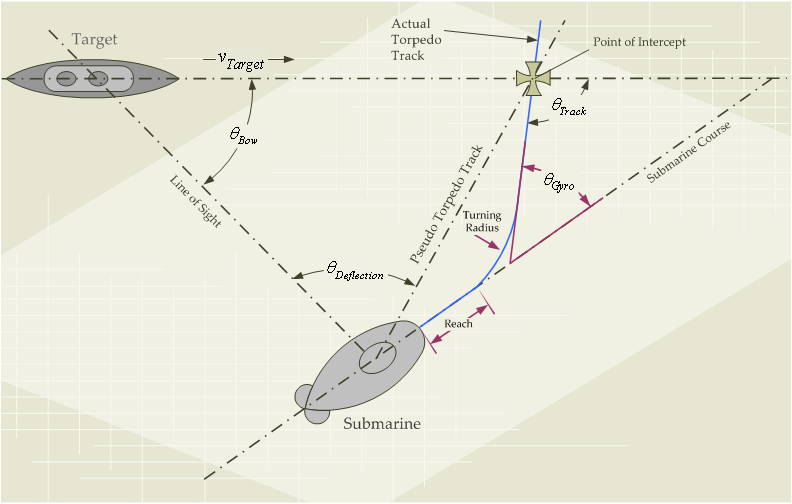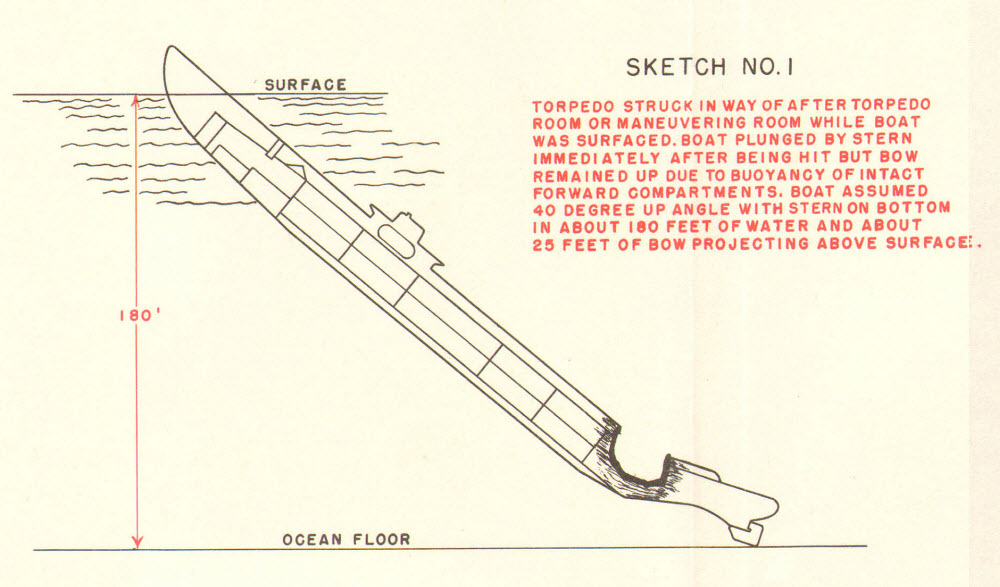
The U.S. Navy submarine USS Tang off the Mare Island Navy Yard, California, December 1943. Photo credit: U.S. Navy
Throughout the Second World War, American submarines were plagued by a variety of torpedo problems such as premature detonation and incorrect depth gauge. The most notorious of these was the tendency to circle back on the firing submarine. This is known as circular run.
Early torpedoes were only straight-running, like bullets fired from a gun, but in the early 20th century before the First World War broke out, torpedoes gained the ability to correct their course towards the target even if fired at a different direction. This correction angle, known as the torpedo's gyro angle, would be set mechanically while the torpedo was still in the tube. After the torpedo was fired, it would travel on a straight course for a short distance called the “reach”. Then the torpedo's gyro steering mechanism would kick in and the torpedo would start turning. After the desired bearing was reached, the torpedo would straighten its course and run towards the target.

A torpedo’s complicated firing calculation.
The problem with many World War 2-era torpedoes was that they would never stop turning, and get right back on the tail of the submarine which fired it. There are at least thirty documented cases of circular runs by torpedoes fired by US submarines at enemy vessels in World War 2. Two of these resulted in fatalities.
The USS Tullibee, sunk on 29 July 1944 with only one survivor, became the first American submarine in World War 2 to be sunk by one of her own torpedoes. The only other submarine to be sunk by a wayward torpedo was the USS Tang. The second incident was notable, because the USS Tang was the most successful of all American submarines deployed during the war. In her short career spanning only two months, USS Tang sank 33 vessels with a gross tonnage of over a hundred thousand tons.
The USS Tang was on her fifth, and what was to be her final patrol, heading for Formosa Strait, now known as the Taiwan Strait, in the South China Sea.
On the night of 23 October 1944, Tang encountered a large enemy convoy consisting of three tankers, a transport, a freighter, and numerous escorts. Tang broke into the middle of the formation and began firing her torpedoes, first at the freighter and then at the tankers. Her aim was spot on, and soon all the targets were either burning or sinking.
The next night, October 24, Tang encountered another large Japanese convoy of tankers with planes on their decks and transports with a cargo of crated planes. Tang released a volley of torpedoes at the convoy, then took off at full speed to try and lose a destroyer and two escorts that was on her tail. Somehow the destroyer blew apart either from intercepting Tang's torpedo or from shell fire of the two escorts. All her torpedoes found their mark, until only one transport remained afloat, dead in the water. Tang’s Commander Richard O'Kane, turned her around and headed towards the lonely vessel to finish off the job. By then, the Tang was down to her last two torpedoes from a total of 24.
At 900 yards, Tang fired her two remaining torpedoes. The first one was observed running hot and straight, but the last torpedo malfunctioned. It curved sharply to the left, circled around and hit Tang on the stern.
One of the survivors, Clayton Oliver Decker, later told in an interview:
The men on the bridge who survived said the last torpedo came out of the tube, went about 300 yards, then came up dancing out of the water. When it dropped back into the water, it had a hard left rudder on it. It circled around on our port side and hit us just ahead of the aft torpedo room and sank us immediately. We started sinking from the stern.
The explosion was so violent that everyone was thrown about against the steel walls and bulkheads. Those who were on the bridge came crashing down the hatch head-first. Many broke their backs and necks.

The way USS Tang sank. Image credit: United States Navy, Bureau of Ships
The submarine bottomed at 180 feet, and the men crowded into the forward torpedo room, intending to use the forward escape trunk. To prevent military secrets from falling into the enemy’s hands, they destroyed all documents. Just then a patrol boat began dropping depth charges, starting an electrical fire in the forward battery. Only thirteen men managed to escape from the forward torpedo room. By the time the last made his exit, the heat from the fire was so intense that the paint on the bulkhead was scorching, melting, and running down. Of the thirteen who escaped, only eight reached the surface. Of this only five were rescued. Four others managed to escape from the bridge before the submarine sank, and were also rescued after 8 hours. Seventy eight others lost their lives.
Of the 24 torpedoes Tang fired in her last patrol, twenty-two torpedoes found their mark in enemy ships, sinking 13 of them. One torpedo missed, and the last torpedo sank Tang. Commanding Officer Richard O'Kane, one of the survivors, was awarded the Medal of Honor. The vessel was awarded the Presidential Unit Citation twice during her career. She also received four battle stars.
No comments:
Post a Comment